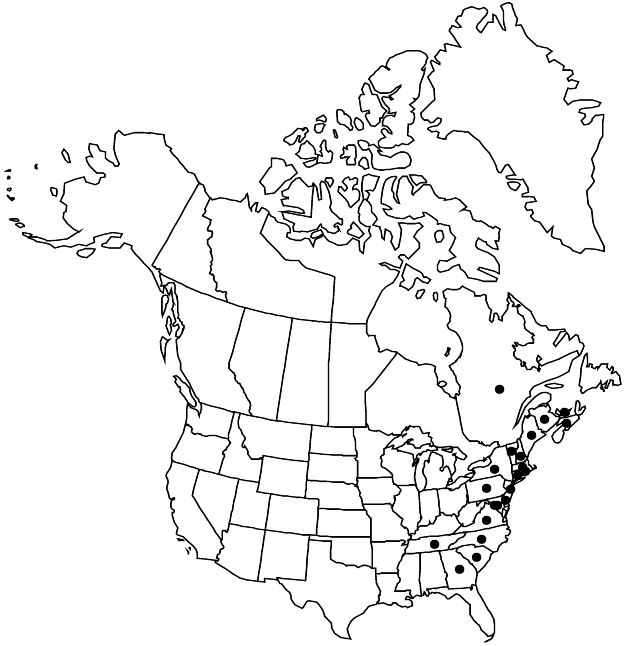Amelanchier canadensis
Gesch. Bot., 79. 1793.
Shrubs, 0.2–8 m. Stems 1–100, in open to dense colonies, evidently stoloniferous in var. obovalis. Leaves less than half-unfolded; petiole (5–)10–15(–25) mm; blade elliptic or oval to oblong or obovate, (24–)34–48(–67) × (12–)18–27(–42) mm, base subcordate, rounded, or cuneate, each margin with (0–)6–15(–29) teeth on proximal 1/2 and (0–)6–12(–17) teeth in distalmost cm, largest teeth less than 1 mm, apex subacute or obtuse to rounded and mucronate, abaxial surface densely hairy by flowering, glabrous or sparsely to moderately hairy later, adaxial glabrous or sparsely (moderately) hairy later. Inflorescences (3–)7–10(–15)-flowered, (6–)15–37(–74) mm. Pedicels: 0 or 1(or 2) subtended by a leaf, proximalmost (1–)5–14(–17) mm. Flowers: sepals erect, ascending, or spreading after flowering, (0.3–)1.8–3.1(–4.6) mm; petals linear, elliptic, or oblong, (4–)6–10.2(–15) × (1.8–)2.6–4(–5.3) mm; stamens (15–)19–21(–28); styles (3–)5(or 6), (1.5–)3.4–4.7(–5.8) mm; ovary apex glabrous (or moderately hairy). Pomes purplish black or maroon-purple, 6–10 mm diam.
Distribution

N.B., N.S., P.E.I., Que., Conn., D.C., Del., Ga., Maine, Mass., Md., N.C., N.H., N.J., N.Y., Pa., R.I., S.C., Tenn., Va., Vt.
Discussion
Varieties 2 (2 in the flora).
The type specimen of Amelanchier canadensis, from Virginia or Canada, includes a single stem with five leaves and the remnants of an infructescence with three fruits. Much of the difficulty in determining the identities of specimens and species distributions owes to the limited diagnostic value of the type. The authors include A. obovalis as a variety of A. canadensis because of ecologic and morphologic similarities. W. W. Ashe (1903) described A. obovalis as a shrub of swamps and loose soils, 9–15 dm or a tree to 4 m with inflorescences 3–5 cm and proximalmost pedicels 3–9 mm at flowering and 20–30 mm in fruit. K. M. Wiegand (1912) described A. canadensis (as A. oblongifolia) as a shrub with slender, erect stems in dense fastigiate colonies with inflorescences 25–60 mm, the proximalmost pedicels 8–18 mm and scarcely longer in fruit. Wiegand was uncertain about placement of specimens of A. obovalis from the southeastern United States and stated that they appeared to be this species. The circumscription by Wiegand of A. oblongifolia and the circumscription by Ashe of A. obovalis overlap considerably. The two species co-occur in similar habitats, have overlapping phenologies, and individual populations may contain specimens with intermediate morphologic characters, especially at early successional sites. Experimental crosses between plants representing the morphologic and ecologic extremes result in formation of mature fruit and seed (C. T. Frye, unpubl.). Plants growing among rocky outcrops in the Potomac River Gorge in Maryland and Virginia suggest A. spicata in growth form and habitat but differ in having glabrous ovary apices and the finely toothed leaves of A. canadensis. These plants are also unusual in that most individuals in the population rarely produce fruits suggesting the presence of locally dominant self-incompatibility allele(s).
Selected References
None.
Key
| 1 | Petals (4–)7–10.2(–15) mm; inflorescences (12–)21–37(–74) mm; proximalmost pedicels (6–)8–14(–17) mm; shrubs 0.5–8 m; stems in open to dense colonies. | Amelanchier canadensis var. canadensis |
| 1 | Petals (5–)6–8(–10.4) mm; inflorescences (6–)15–27(–45) mm; proximalmost pedicels (1–)5–10(–15) mm; shrubs 0.2–2 m; stems in dense colonies, often evidently stoloniferous. | Amelanchier canadensis var. obovalis |